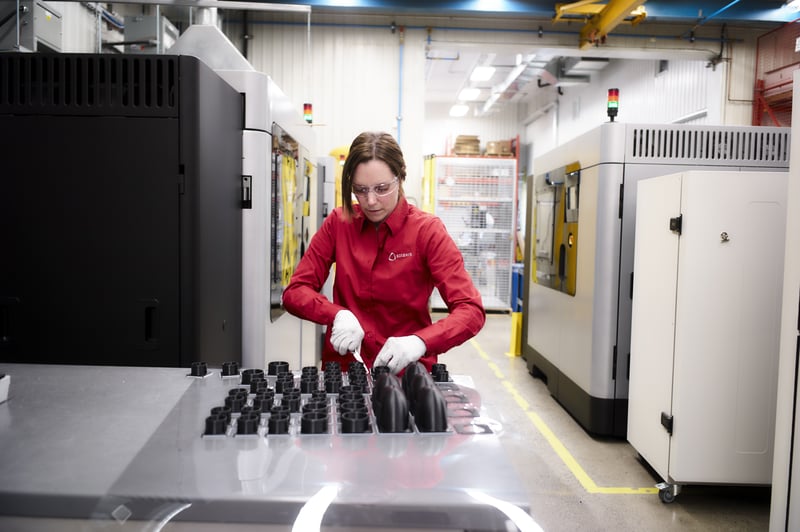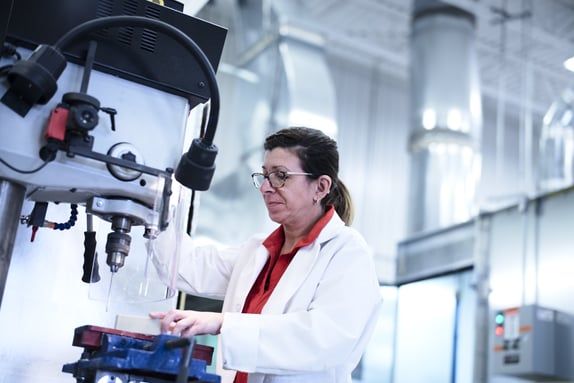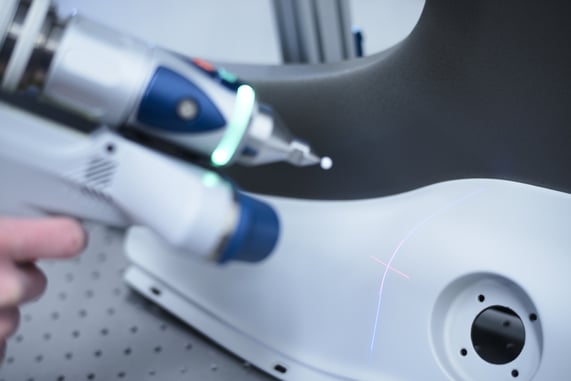Everything You Need to Know About Low-Volume Production
-
By
Marie-Christine Flibotte
September 26 2023
-
Tech tips and tutorials

Thanks to technological advances in recent years, low-volume production has become an approach of choice for many industrial companies. It stands out for rapid and low-cost manufacturing for small series of end-use parts.
Finding the right manufacturing solution for small production projects is not always easy because each project is unique. For various reasons, manufacturers may have to question their manufacturing approach. Discover the different factors to consider for low-volume production, the benefits, the various processes available to you, and the possible applications.
What Is Low-volume Production?
4 Things to Consider for Low-volume Manufacturing
Popular Low-volume Production Processes
The Advantages of Low-Volume Production
Applications of Low-Volume Production
Low-Volume Production: Case Study
What Is Low-volume Production?
Low-volume production is defined by the manufacture of several different products in small quantities. It promotes innovation, iterations, agility and increased responsiveness to opportunities.
Thus, it is the opposite of mass manufacturing, where the emphasis is placed on the manufacture of a very large number of identical and standardized products to benefit from an economy of scale. The growing demand for personalized products and the limits of mass production have certainly encouraged manufacturing companies to adopt alternative strategies, such as low-volume manufacturing.
Low-volume production generally refers to manufacturing 10 to 10,000 parts. It is also seen as a bridge between rapid prototyping and large-scale production, that is, in millions of parts. For sure, the definition of “low-volume production” is quite subjective. It is not easy to provide precise quantitative data, because it is relative to the field of application. For example, a few thousand parts in the automotive field will be considered as a small series, while for a more specialized sector, it will be considered as a large volume.
However, we can associate different expressions with it: “pre-production”, “short cycle time”, “small quantities”, “low investment”, or “custom orders”. Short-run or low-volume manufacturing is a specialized service offering production-quality parts but in limited volumes.
4 Things to Consider for Low-volume Manufacturing

It is clearly established that low-volume production methods generate interesting financial gains for certain types of projects.
However, before opting for this approach, several things should be considered. Here are some key points that can influence your choice:
- The size of the market or the number of potential customers is limited. Indeed, it may be interesting to opt for a low-volume production to assess the interest of the customers.
- The quantity of parts to be produced over a given period of time is limited or uncertain.
- The design complexity is high. A low-volume production method is then better suited and less risky.
- Design changes and revisions are planned. Low-volume manufacturing is an approach of choice in such a case, as it gives the company the flexibility of making changes or revisions to the part more easily without affecting the overall cost of the parts.
- The options available in terms of materials vary according to the processes. The materials offered must therefore be validated and obviously suitable for “production” quality.
Popular Low-volume Production Processes
Several processes can be used for low-volume production:
CNC Machining
Computer Numerical Control (CNC) machining is an automated manufacturing process. Milling machines, grinders, and other machine tools are programmed to machine the parts.
This subtractive approach is interesting for low-volume series production since it makes it possible to manufacture quality and high-precision parts, almost regardless of their geometric complexity and the material used. Moreover, investments in terms of tooling and labour are minimal. The downside? Material losses can be significant and costly, and the complexity of parts can greatly affect costs.
This method is generally used to manufacture more or less quickly a few high-quality plastic or steel parts, which require an excellent finish, close tolerances, and specific properties of the material.
Injection Molding
Injection molding requires the production of a custom-made mold in which the material is cast to create the part. Once cooled, the latter is removed from the mold.
These parts stand out for their precision, resistance, durability, and repeatability. It is certain that the development of the mold as well as the manufacturing process of the parts can be expensive and time-consuming. However, today, thanks to rapid tooling, this approach is considered for the production of low-volume series. The time saved makes it possible to partially overcome the cost factor.
Additive manufacturing

Additive manufacturing or industrial 3D printing consists in manufacturing parts by adding material in successive layers.
Unlike subtractive approaches such as machining, material losses are reduced and compared to injection molding, the development of a mold is not required, saving time and money.
3D printing makes it possible to produce parts in low-volume series characterized by their complex geometry, without increasing costs as with machining. The physical and mechanical properties (robustness, durability) of 3D parts relate to materials and production systems. Moreover, there are more and more productions made by additive manufacturing. It is remarkable for its low-cost and short-delay manufacturing, its reliability, and its innovation prospects.
There are many additive manufacturing processes and the choice of materials is substantial. It is therefore of the utmost importance to define the appropriate technology according to the part to be manufactured, but also to ensure whether post-treatment steps are required.
The Advantages of Low-volume Production
The main reasons manufacturers opt for low-volume manufacturing methods are:
- More agile manufacturing model
- More innovation and customization
- Risk reduction
- Shorter production time
- Reduction of investment in tooling
- Reduced need for labour
- Significant design flexibility
- Reduction of material losses
- Rapid introduction of the product on the market
Applications of Low-volume Production

On many levels, it is more optimal and less risky to produce in smaller batches than to opt for mass production.
In other words, low-volume production is adequate to:
- Manufacture personalized products.
- Manufacture complex and highly specialized parts.
- Produce more innovative products.
- Manufacture test and pre-production parts.
- Produce short runs temporarily, quickly and at low cost, during periods of shortage for example.
- Produce replacement parts.
- Manufacture various components to be produced in limited batches by the nature of the application.
Low-volume production therefore finds its place in many sectors, such as aerospace, defense, electronics, health, industrial, transport or even robotics.
Low-volume Production: Case Study
Here is an example in the railway sector, where low-volume production is well suited because it involves designing personalized parts for which quantities remain limited.
Solaxis was asked to manufacture casings for the electrical switches located in the locomotives. The parts were manufactured using SLS 3D printing because the challenges were concerning the manufacturing delays, the complex geometry of the casings versus the layout of the electrical components, the properties of the part (robustness), and the limited quantities (+/- 100 boxes/year).
See the case study
In summary, it remains imperative to analyze the needs of the market, the characteristics of the parts to be produced, but also the context or the goals of the company before opting for low-volume production. This solution offers many advantages, particularly on the financial aspect, and different processes can be adopted to produce the parts (CNC machining, injection molding, additive manufacturing). All have their own advantages.
At Solaxis, we specialize in industrial 3D printing of thermoplastic parts. Our fast-turnaround additive manufacturing services offer low to medium-volume production with superior quality and short-cycle time to help you get products to market quickly.
Questions about additive manufacturing for low-volume production? Contact us today, and our team of specialists will be happy to answer you.


